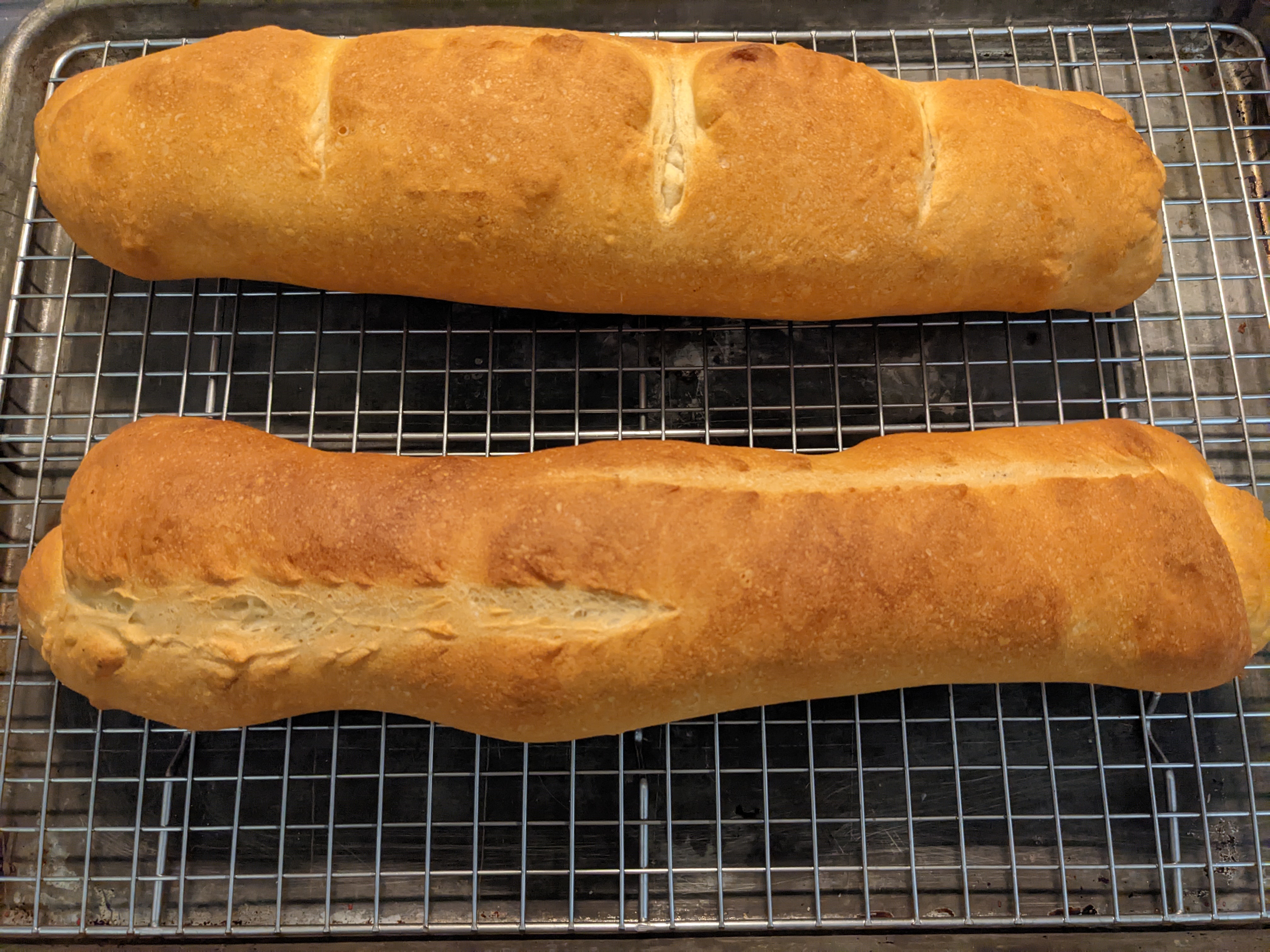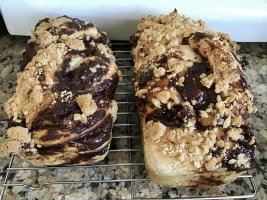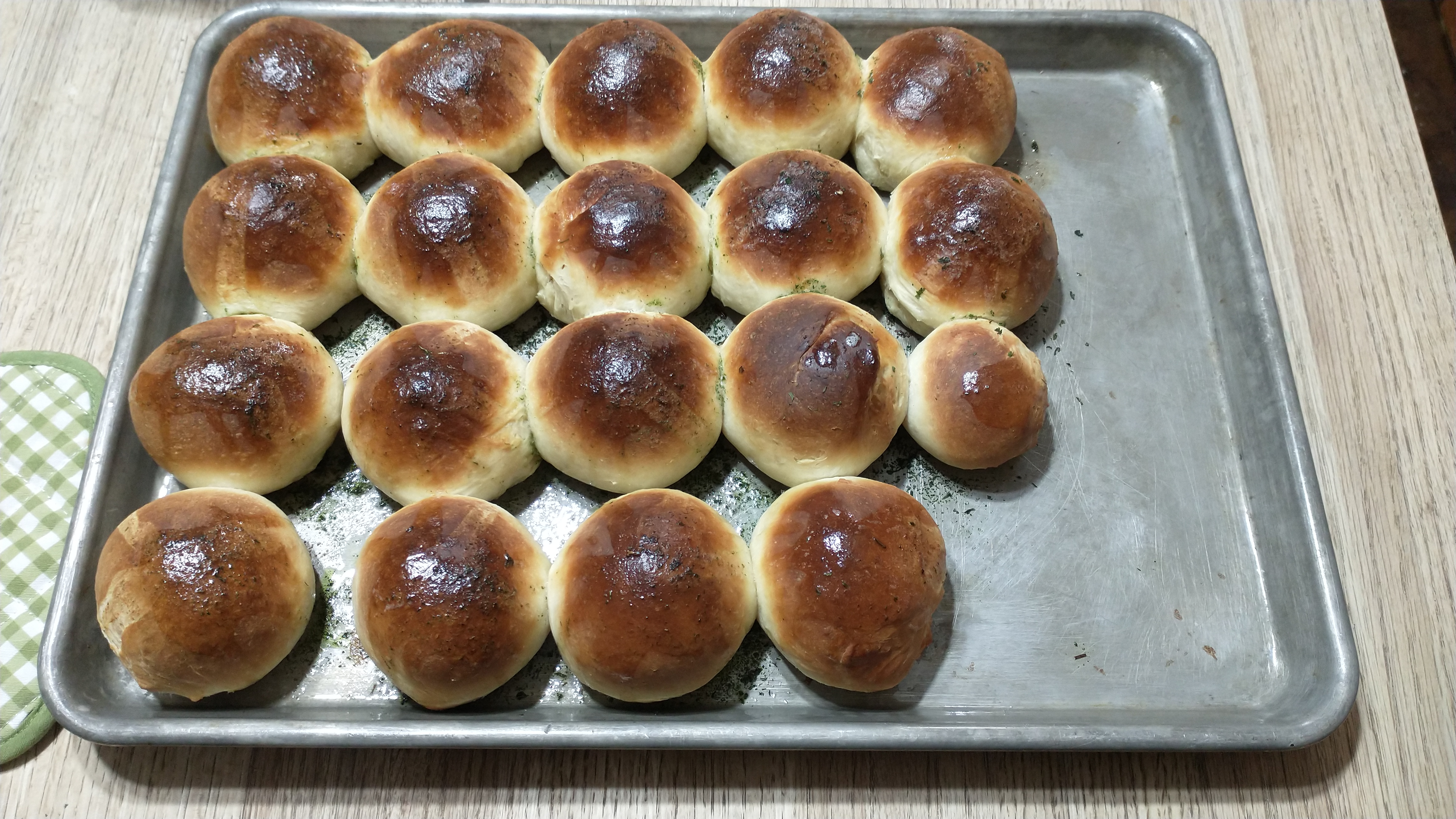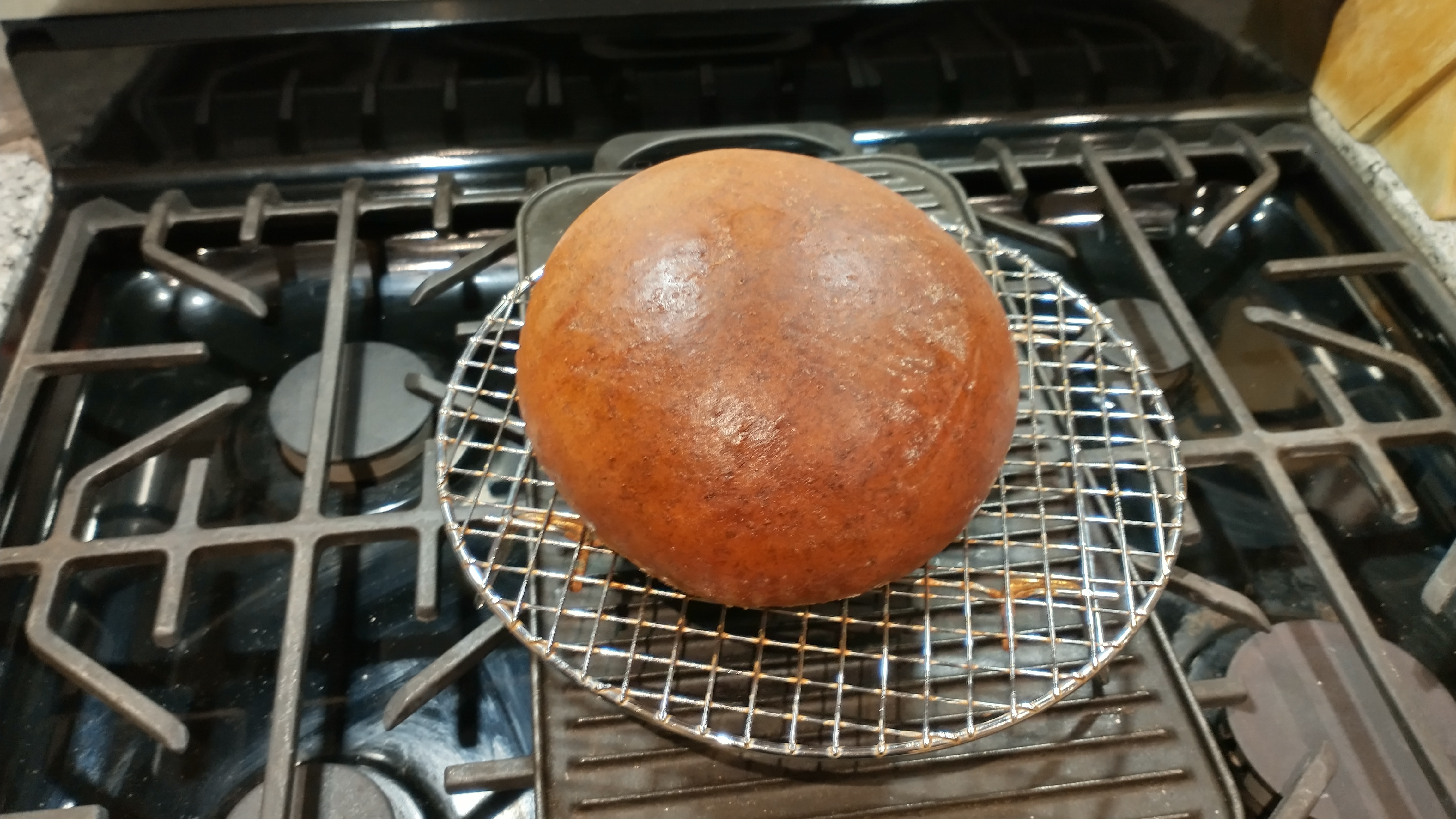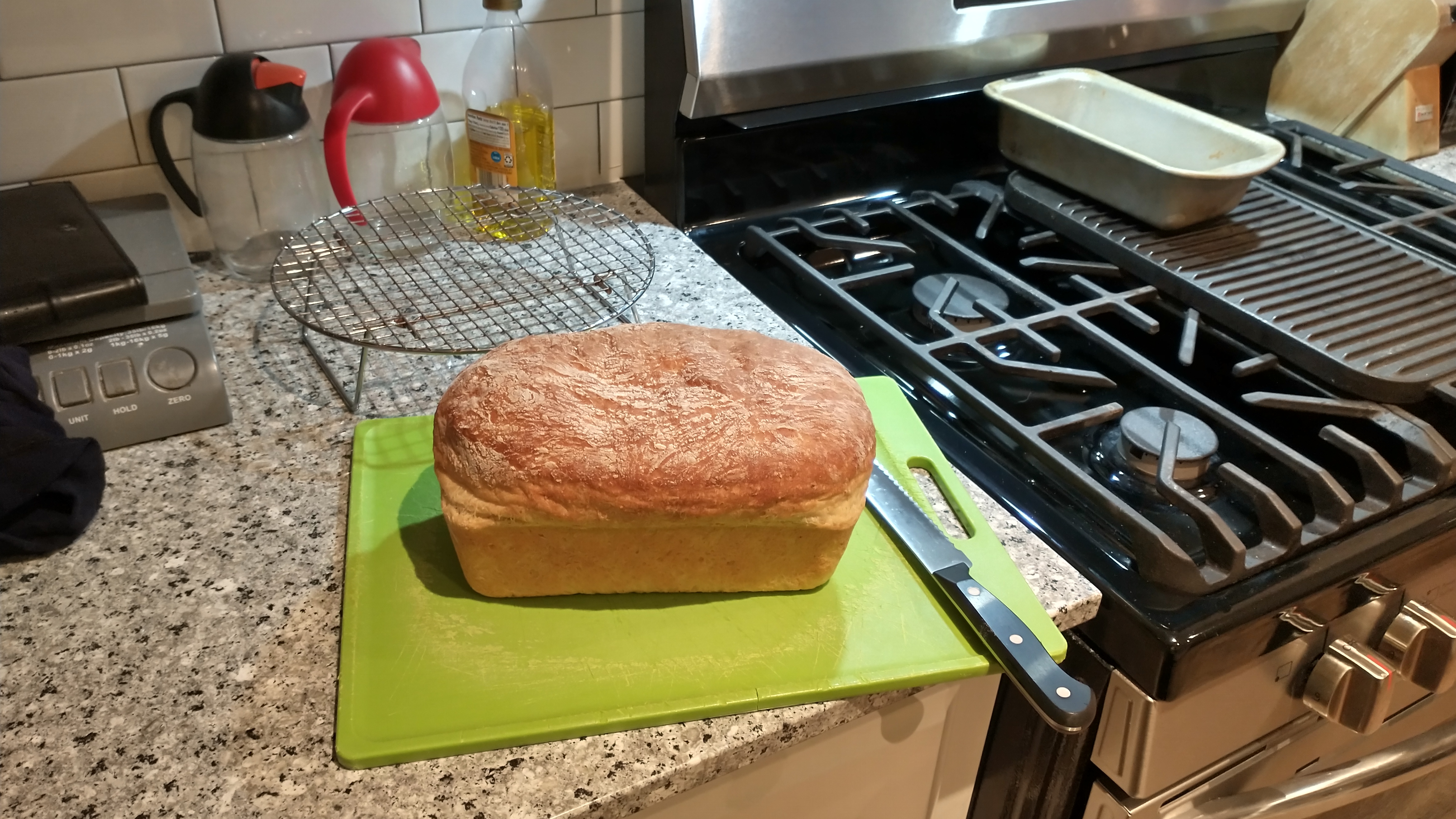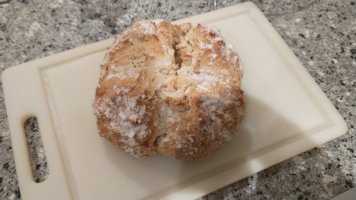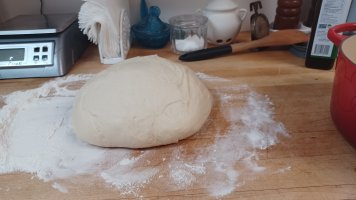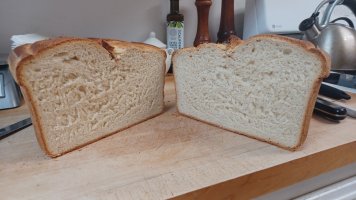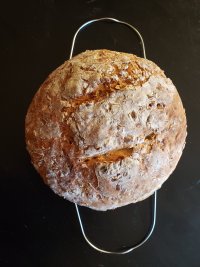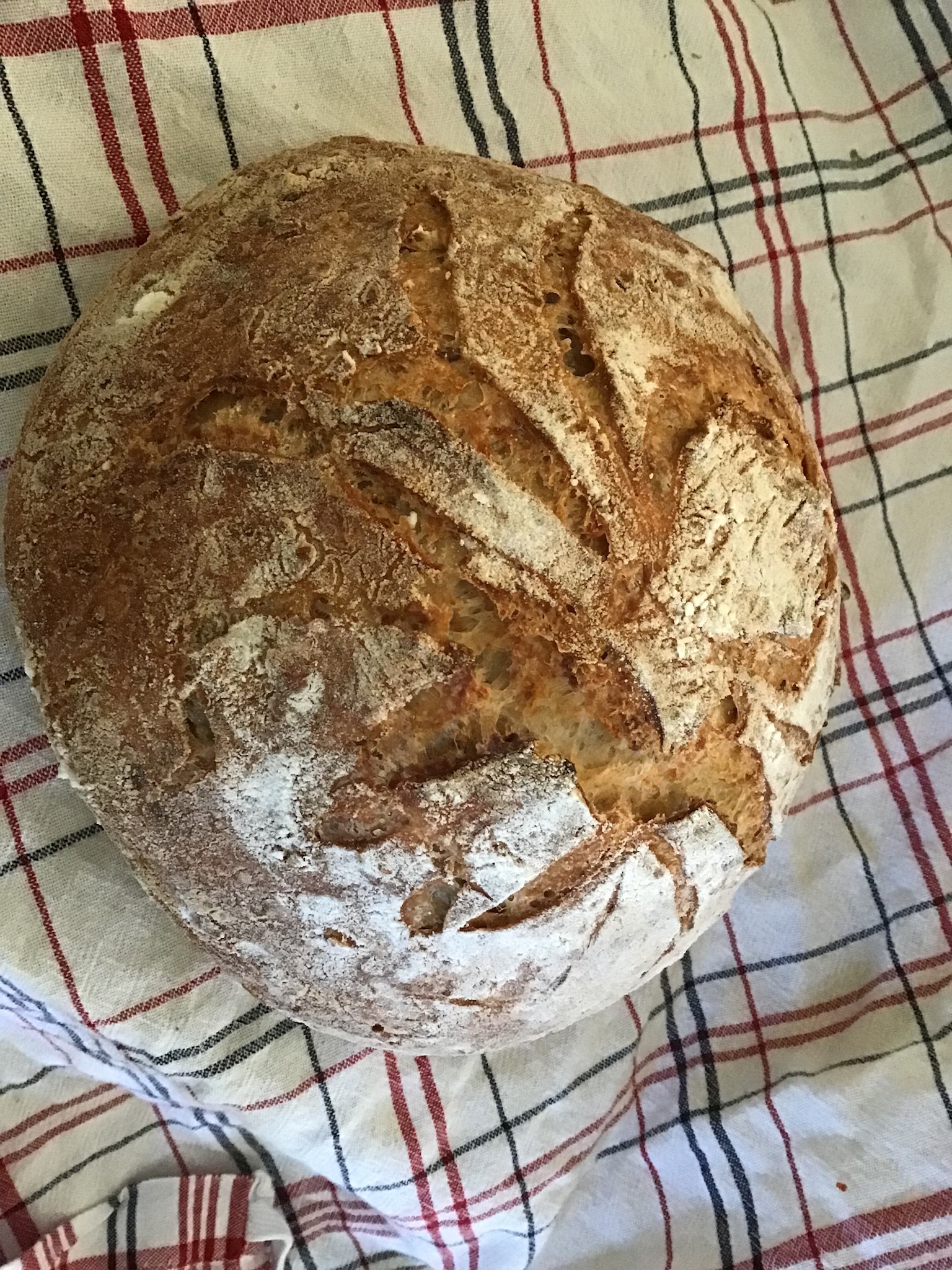
You are using an out of date browser. It may not display this or other websites correctly.
You should upgrade or use an alternative browser.
You should upgrade or use an alternative browser.
Homemade Bread Thread
- Thread starter deadfall
- Start date

Help Support Homebrew Talk - Beer, Wine, Mead, & Cider Brewing Discussion Forum:
This site may earn a commission from merchant affiliate
links, including eBay, Amazon, and others.
DuncB
Well-Known Member
If you say so, I thought it might have been a marijuana leaf.Big spider scored on a small boule. Lightly enriched sourdough with added grains.
Looks great though.
Thanks, trust me it has 8 legs, not 5 leaves.If you say so, I thought it might have been a marijuana leaf.
Looks great though.
TandemTails
Well-Known Member
Green chile + gruyere sourdough loaves.
I typically use Gouda in these loaves but the Gruyere makes a nice change. Full recipe here: Green Chile + Gruyere Sourdough
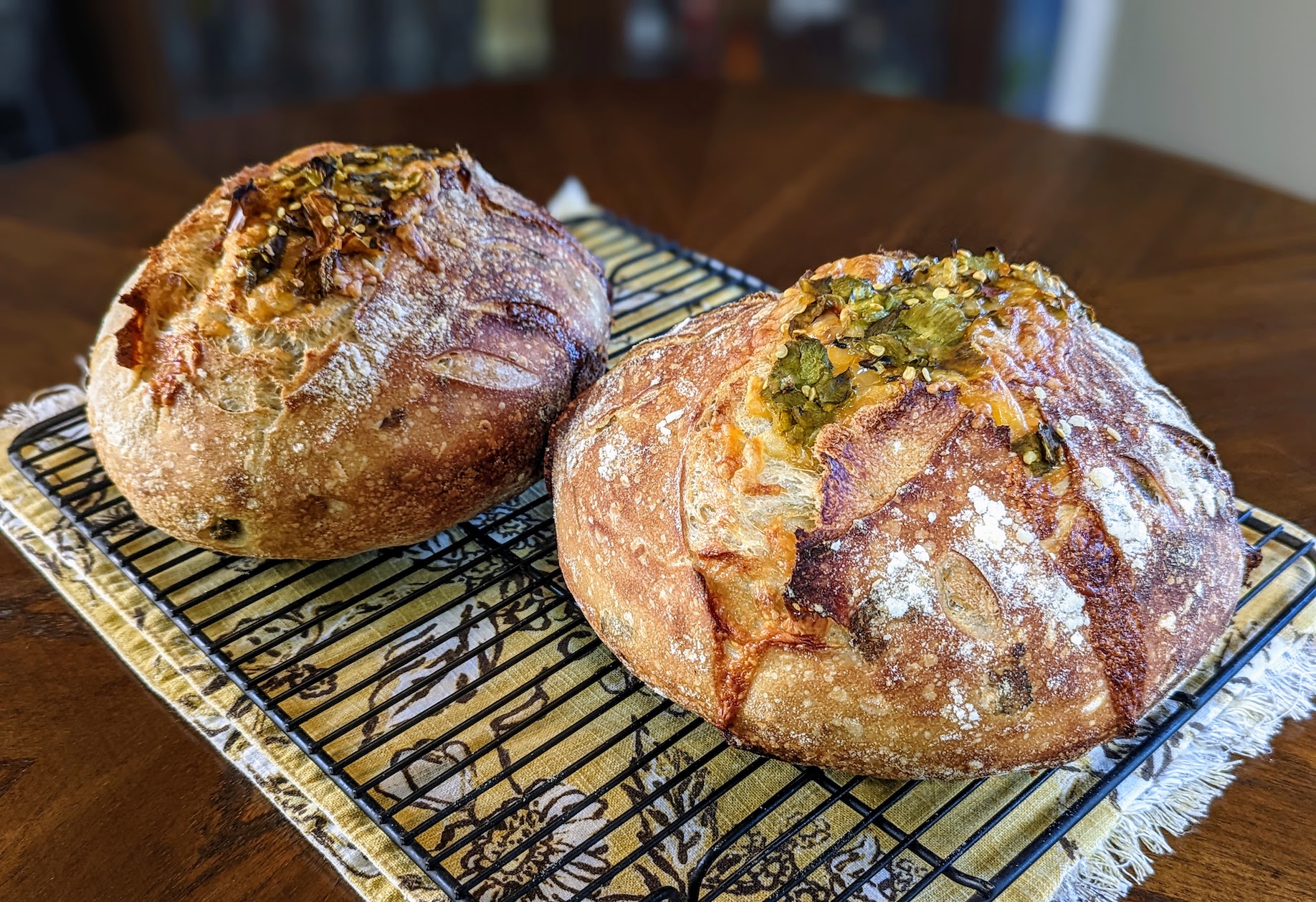
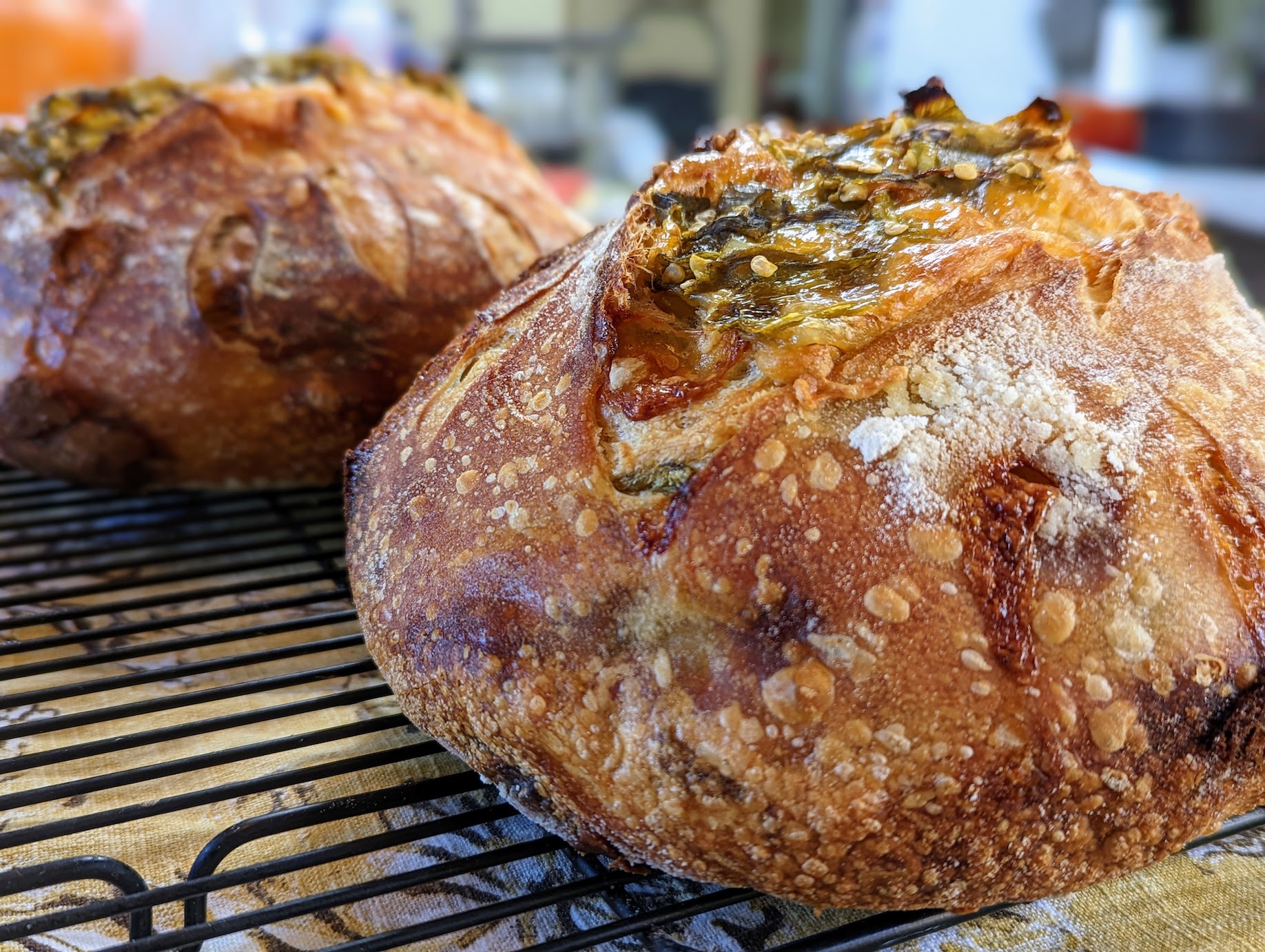
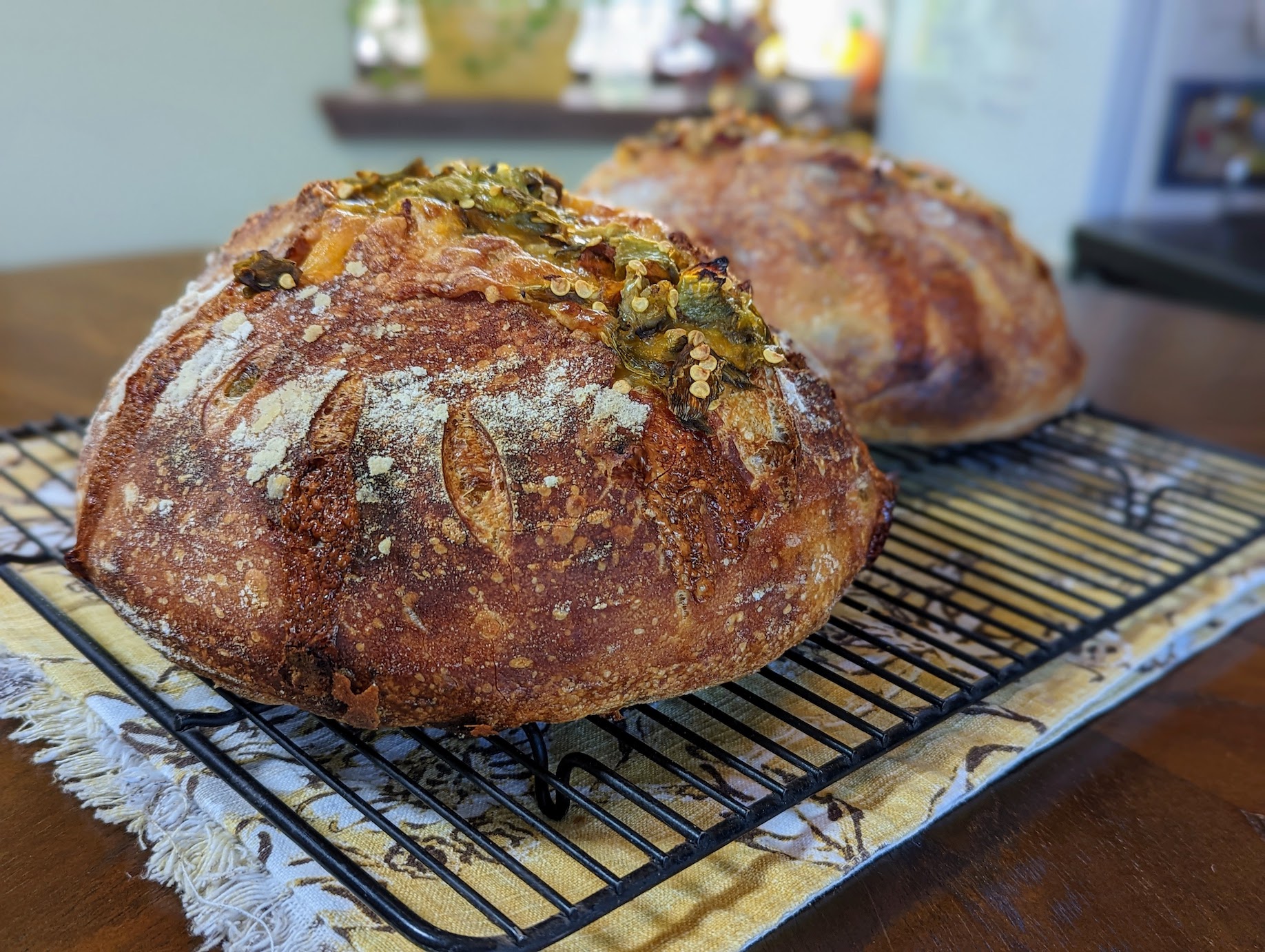
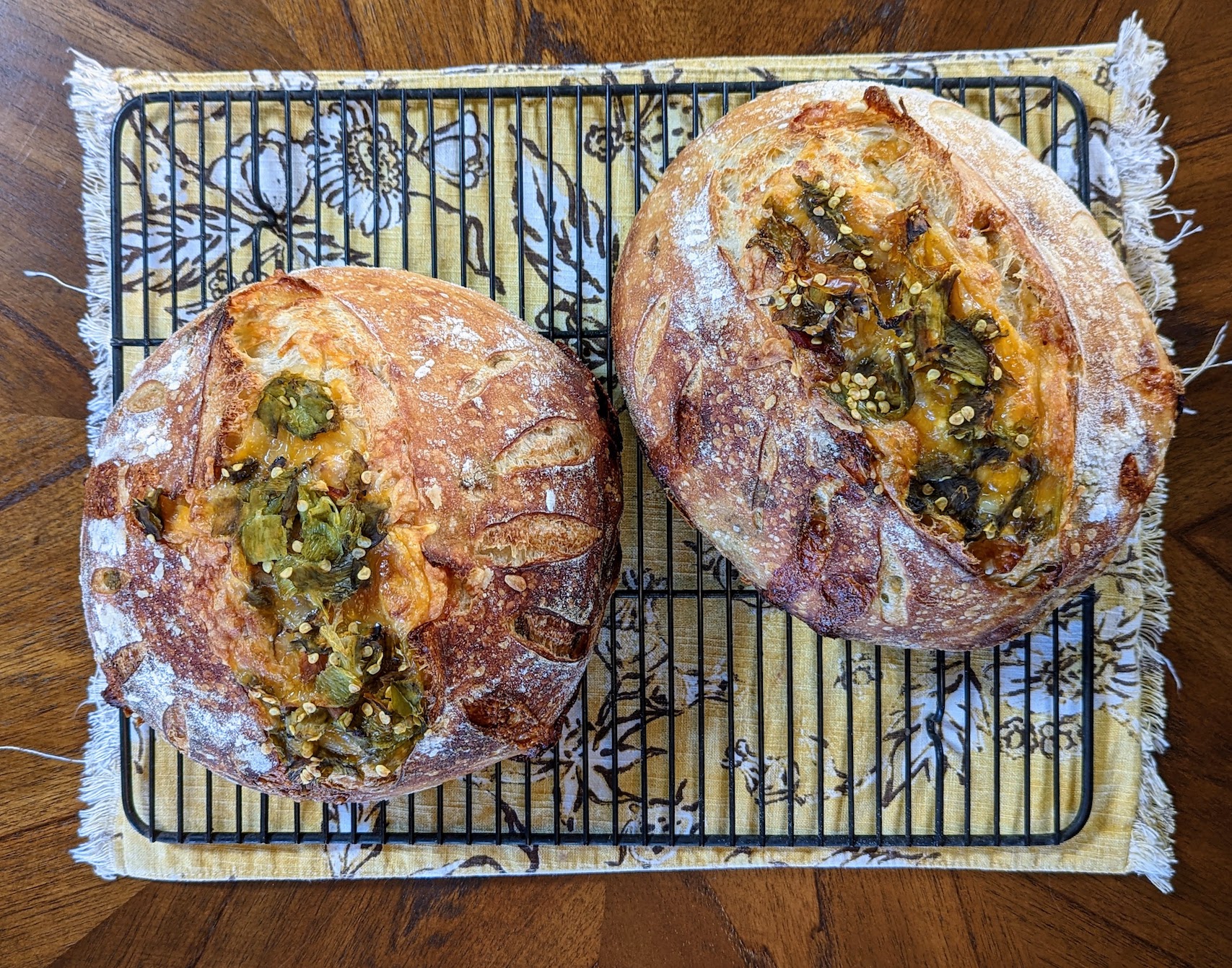
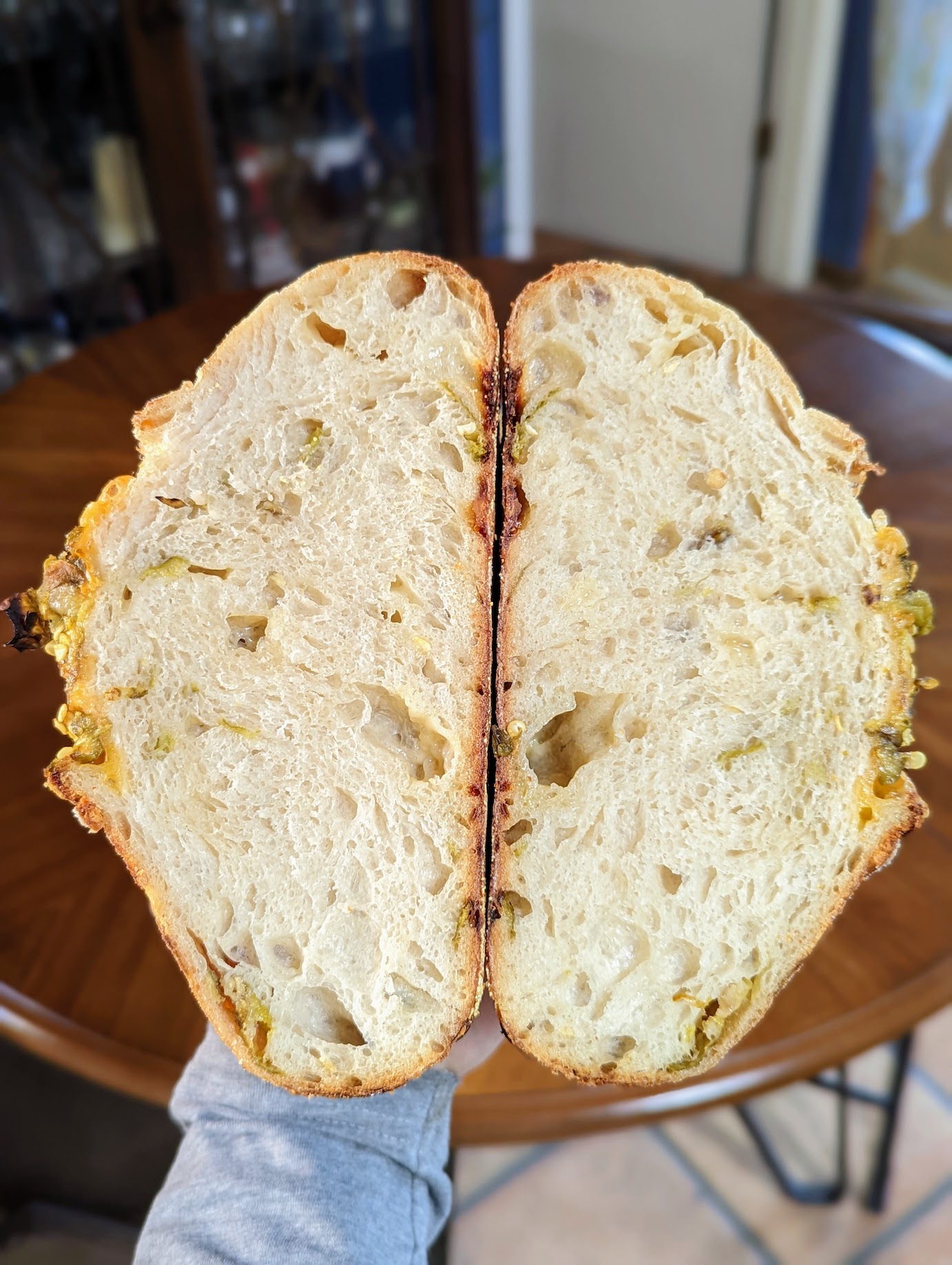
I typically use Gouda in these loaves but the Gruyere makes a nice change. Full recipe here: Green Chile + Gruyere Sourdough






Simple Whole Wheat Bread
I made a little preferment with a sprinkle of yeast, a cup of water, and a half cup each of both bread and wheat flours and let it sit overnight. I'll see if it was worthwhile
I just started some bread for slicing and making toast in the morning. I should know by now to weigh all the ingredients rather than eyeballing it because I don't do this enough to have a well-calibrated eye. But I proofed a heaping teaspoon of yeast in 1/4 cup of warm water. Mixed 2 cups of bread flour, 1 cup of whole wheat flour, the yeastwater, and a little over a cup of warm water. Added a few tablespoons of homemade orange marmalade that I made 2 years ago and it still tastes good but is turning dark. When that rises at least double, I will add 1 tsp of salt, another cup of WW flour, some raisins, and however little water it takes to get a workable but wet dough. Let it rise again, shape into loaf pans, rise one more time, and bake.
I'm not really sure how to use bakers' percentages when I'm adding significant amounts of stuff like marmalade, apple butter, grated fresh pumpkin, etc. Perhaps just assume they are 50% water and go with that.
The last 50% whole wheat bread I made that had half a pound of grated squash in it turned out really good and made great toast. A lot better than the previous batch where I liquified the squash with the water first. (I had a *lot* of not-quite-ripe winter squash that I was trying to use up)
The pictures in this thread are gorgeous.
I'm not really sure how to use bakers' percentages when I'm adding significant amounts of stuff like marmalade, apple butter, grated fresh pumpkin, etc. Perhaps just assume they are 50% water and go with that.
The last 50% whole wheat bread I made that had half a pound of grated squash in it turned out really good and made great toast. A lot better than the previous batch where I liquified the squash with the water first. (I had a *lot* of not-quite-ripe winter squash that I was trying to use up)
The pictures in this thread are gorgeous.
I really don’t think I have enough experience to advise you, but I think you are on the right track understanding that those additions also add to the hydration. Pro bakers generally don’t eyeball ingredients, but if they make the same dough over and over they certainly would gain an ability to judge how much is the right amount just like a granny. Different qualities of flour also creat a variation.I just started some bread for slicing and making toast in the morning. I should know by now to weigh all the ingredients rather than eyeballing it because I don't do this enough to have a well-calibrated eye. But I proofed a heaping teaspoon of yeast in 1/4 cup of warm water. Mixed 2 cups of bread flour, 1 cup of whole wheat flour, the yeastwater, and a little over a cup of warm water. Added a few tablespoons of homemade orange marmalade that I made 2 years ago and it still tastes good but is turning dark. When that rises at least double, I will add 1 tsp of salt, another cup of WW flour, some raisins, and however little water it takes to get a workable but wet dough. Let it rise again, shape into loaf pans, rise one more time, and bake.
I'm not really sure how to use bakers' percentages when I'm adding significant amounts of stuff like marmalade, apple butter, grated fresh pumpkin, etc. Perhaps just assume they are 50% water and go with that.
The last 50% whole wheat bread I made that had half a pound of grated squash in it turned out really good and made great toast. A lot better than the previous batch where I liquified the squash with the water first. (I had a *lot* of not-quite-ripe winter squash that I was trying to use up)
The pictures in this thread are gorgeous.
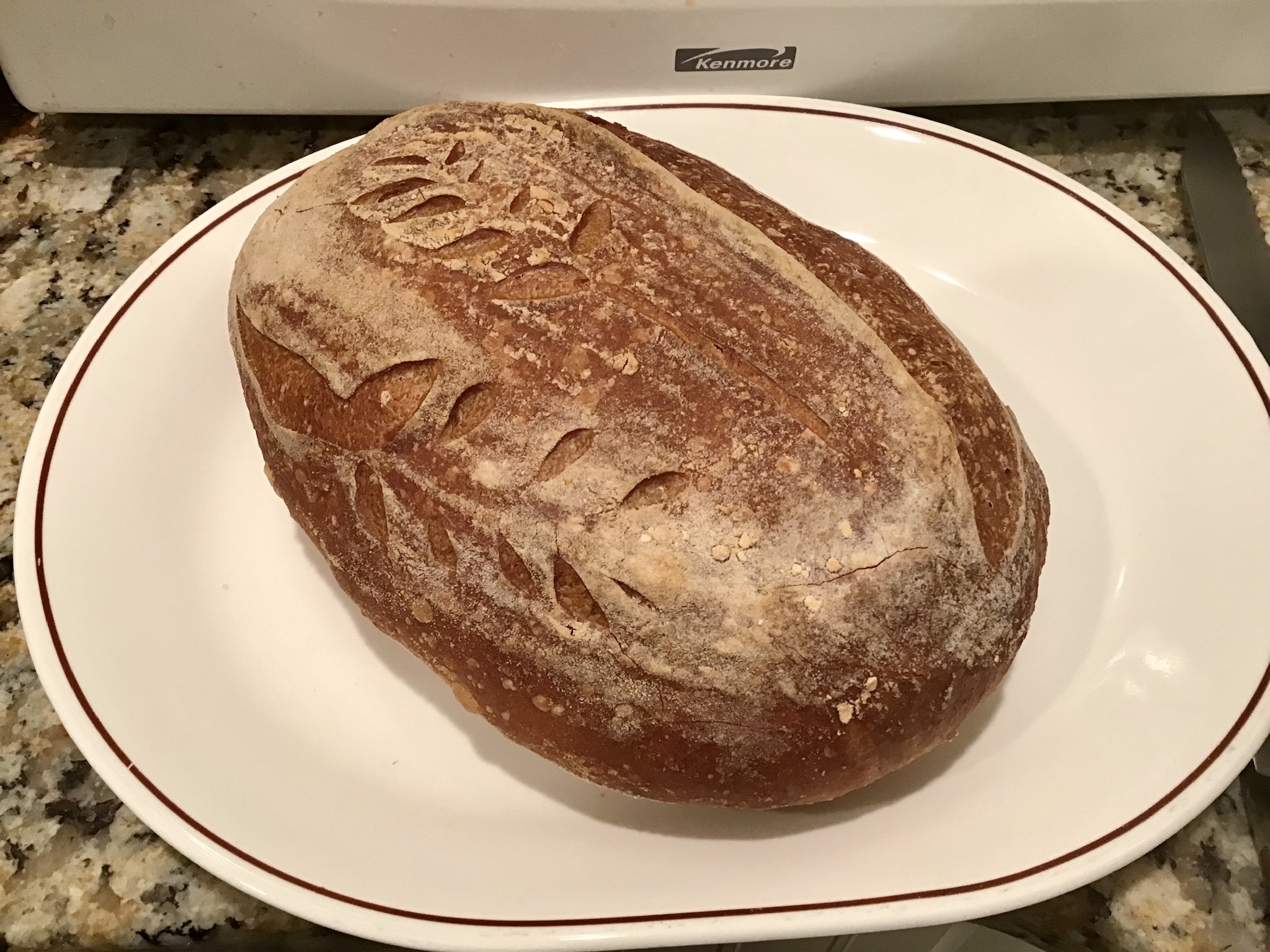
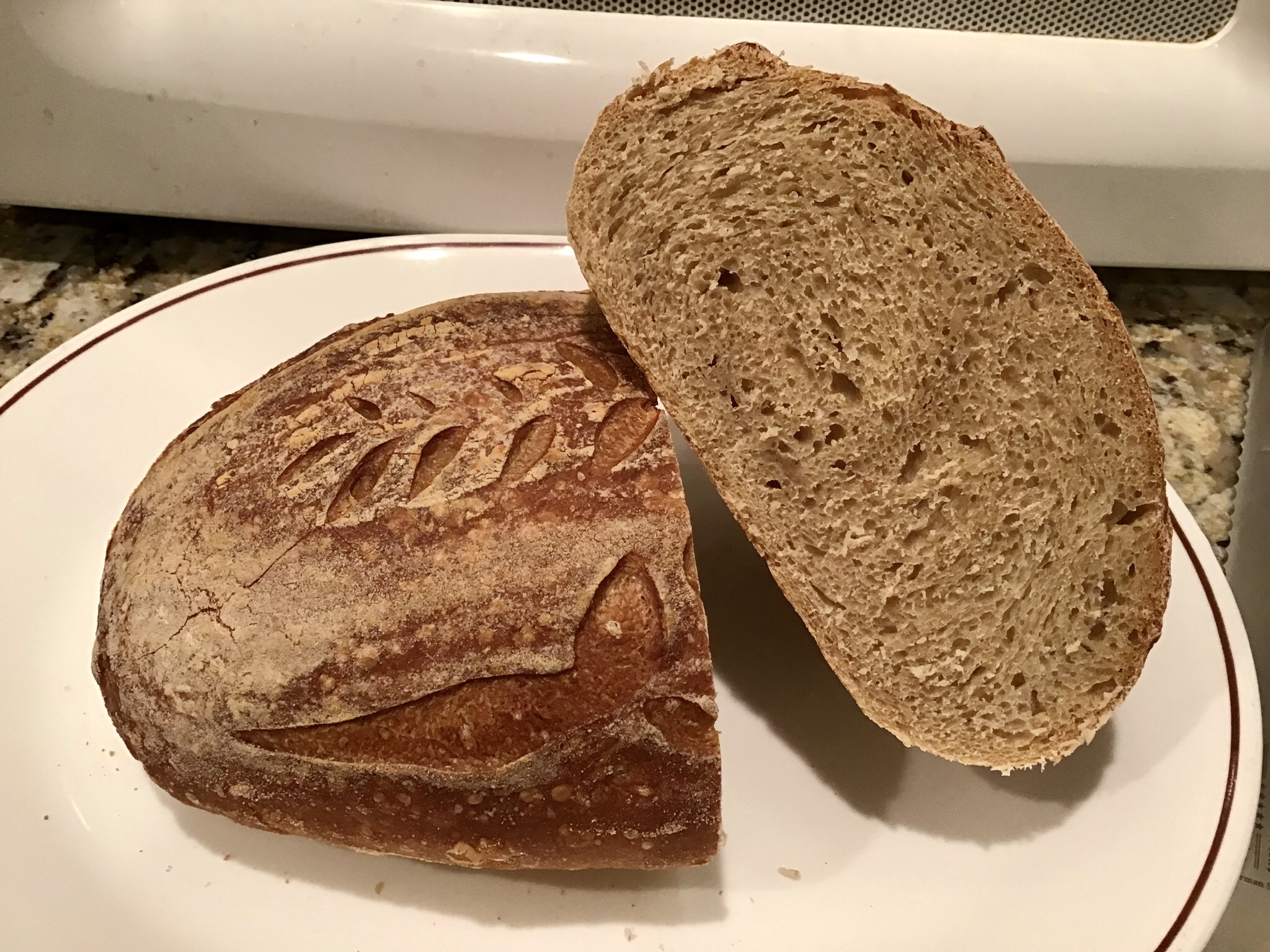
Sourdough babka, the smaller one is chocolate and the larger loaf is strawberry walnut. Yes the larger loaf is the lesser babka. 
Attachments
Looks great!Sourdough babka, the smaller one is chocolate and the larger loaf is strawberry walnut. Yes the larger loaf is the lesser babka.
Thanks, they look a bit more “professional” than my first batch… I’ve gotten better at shaping, but it’s still like wrangling live eels!Looks great!
@Hoppy2bmerry Your babka look delicious, nice and tender looking too. Is your starter very sour and does it comes through in the final product?
Guessing the dough might have sugar and the filling sweet to offset any sourness but a touch of sour might be good with the strawberry one. My starter is not very sour but the texture of the bread is different from commercial dry yeast so there is something different about it.
Guessing the dough might have sugar and the filling sweet to offset any sourness but a touch of sour might be good with the strawberry one. My starter is not very sour but the texture of the bread is different from commercial dry yeast so there is something different about it.
This is an enriched dough I used coconut milk for 2/3s the hydration the remaining 1/3 water, 15g sugar and one egg. Bulk fermentation takes a little longer for enriched dough. My starter is probably on the tart side as. It lives in the fridge, and these spent overnight in the fridge once they were in their parchment lined pans So some tanginess come through, but it’s mild and adds a nice layer of flavor which works for both. They are tender, soft and moist, but they won’t be as good tomorrow unfortunately. the coconut milk didn’t seem to impart any detectable flavor, but adds a tiny bit of fat that softens the bread as well.@Hoppy2bmerry Your babka look delicious, nice and tender looking too. Is your starter very sour and does it comes through in the final product?
Guessing the dough might have sugar and the filling sweet to offset any sourness but a touch of sour might be good with the strawberry one. My starter is not very sour but the texture of the bread is different from commercial dry yeast so there is something different about it.
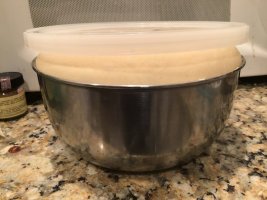
it was ready to be shaped at this point and rose a little more while in the cold.
I paid attention to what I was doing with the last loaves of 50% WW I made, but I didn't write everything down so not sure I remember it all exactly. But this is really close and might be exact: 500g of bread flour, 500g of warm water, heaping tsp of yeast. Let that ripen all day. Added 500g of WW flour, 150g of orange marmalade, 1.5 tsp salt, 150g of water and a handful of raisins. Mixed it all up and let it rise until triple. Punched it down and kneaded it a bit, and let it rise again. Divided the dough in half into 2 loaf pans and put in it a warm oven with the light on and a pan of boiling water in the bottom. When the dough was climbing out of the pans, I baked it; shooting for 190°F but it was almost 200 when I checked it (oops) and took it out. The bread is good and makes wonderful toast, but the crust is very hard and I have to be careful when I slice it; almost cut my finger off once when the knife slipped but luckily just got a small cut.
I've also figure out that ingredients like raisins shouldn't be mixed into the dough but the dough rolled out, the raisins sprinkled on, then rolled up like a jellyroll. The reason being that any raisins that end up on the top surface will burn, so make sure they are all inside. (this dough was a bit sticky so not sure how I'd manage that)
How do you keep the top crust from drying out and overcooking? Brush it with melted butter before you bake it?
I've also figure out that ingredients like raisins shouldn't be mixed into the dough but the dough rolled out, the raisins sprinkled on, then rolled up like a jellyroll. The reason being that any raisins that end up on the top surface will burn, so make sure they are all inside. (this dough was a bit sticky so not sure how I'd manage that)
How do you keep the top crust from drying out and overcooking? Brush it with melted butter before you bake it?
What temperature are you bake them, and when do you remove the pan of water, or how far into the baking time does it last? Increased humidity during the bake should make for a less thick crust. Also wrapping in a tea towel while it is just a touch warm should soften the crust as well.I paid attention to what I was doing with the last loaves of 50% WW I made, but I didn't write everything down so not sure I remember it all exactly. But this is really close and might be exact: 500g of bread flour, 500g of warm water, heaping tsp of yeast. Let that ripen all day. Added 500g of WW flour, 150g of orange marmalade, 1.5 tsp salt, 150g of water and a handful of raisins. Mixed it all up and let it rise until triple. Punched it down and kneaded it a bit, and let it rise again. Divided the dough in half into 2 loaf pans and put in it a warm oven with the light on and a pan of boiling water in the bottom. When the dough was climbing out of the pans, I baked it; shooting for 190°F but it was almost 200 when I checked it (oops) and took it out. The bread is good and makes wonderful toast, but the crust is very hard and I have to be careful when I slice it; almost cut my finger off once when the knife slipped but luckily just got a small cut.
I've also figure out that ingredients like raisins shouldn't be mixed into the dough but the dough rolled out, the raisins sprinkled on, then rolled up like a jellyroll. The reason being that any raisins that end up on the top surface will burn, so make sure they are all inside. (this dough was a bit sticky so not sure how I'd manage that)
How do you keep the top crust from drying out and overcooking? Brush it with melted butter before you bake it?
estricklin
Well-Known Member
Been trying to read through this thread and catch up, I bake bread pretty much every week, but I don't usually take photos. Here's some from the past year or so, including sweet potato bread, Irish soda bread, Polish sweet bread, and various others. I make hot dog buns, sub bread and potato bread the most.
Attachments
-
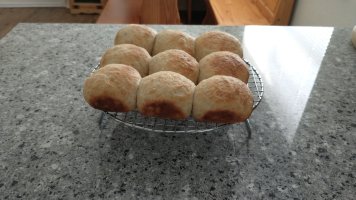 IMG_20210819_172249363.jpg3.5 MB · Views: 0
IMG_20210819_172249363.jpg3.5 MB · Views: 0 -
 IMG_20210214_213330108_HDR.jpg3 MB · Views: 0
IMG_20210214_213330108_HDR.jpg3 MB · Views: 0 -
 IMG_20210813_191755719.jpg2.7 MB · Views: 0
IMG_20210813_191755719.jpg2.7 MB · Views: 0 -
 IMG_20210721_211603417.jpg2.8 MB · Views: 0
IMG_20210721_211603417.jpg2.8 MB · Views: 0 -
 IMG_20210718_190025768.jpg2.8 MB · Views: 0
IMG_20210718_190025768.jpg2.8 MB · Views: 0 -
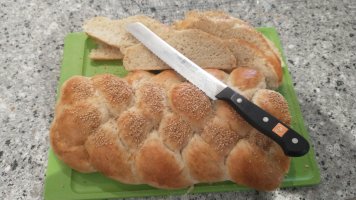 IMG_20210627_181433305.jpg3 MB · Views: 0
IMG_20210627_181433305.jpg3 MB · Views: 0 -
 IMG_20210620_194511233.jpg2.7 MB · Views: 0
IMG_20210620_194511233.jpg2.7 MB · Views: 0 -
 IMG_20210526_190414313.jpg3 MB · Views: 0
IMG_20210526_190414313.jpg3 MB · Views: 0 -
 IMG_20210303_203924699_HDR.jpg3.5 MB · Views: 0
IMG_20210303_203924699_HDR.jpg3.5 MB · Views: 0 -
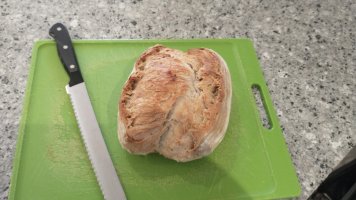 IMG_20210221_110757587.jpg3.5 MB · Views: 0
IMG_20210221_110757587.jpg3.5 MB · Views: 0 -
 IMG_20210129_171050541.jpg1.2 MB · Views: 0
IMG_20210129_171050541.jpg1.2 MB · Views: 0 -
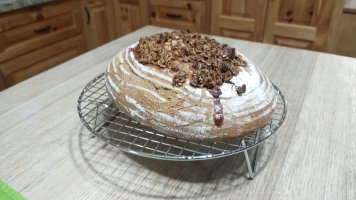 IMG_20201116_183456698.jpg3.5 MB · Views: 0
IMG_20201116_183456698.jpg3.5 MB · Views: 0 -
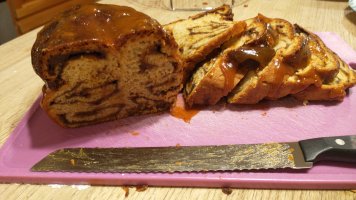 IMG_20201114_200201222.jpg3.9 MB · Views: 0
IMG_20201114_200201222.jpg3.9 MB · Views: 0 -
 IMG_20201114_195601178.jpg3.1 MB · Views: 0
IMG_20201114_195601178.jpg3.1 MB · Views: 0 -
 IMG_20201028_171231884.jpg3.8 MB · Views: 0
IMG_20201028_171231884.jpg3.8 MB · Views: 0 -
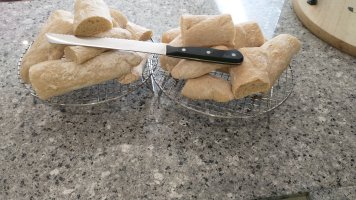 IMG_20210829_171141623.jpg4.1 MB · Views: 0
IMG_20210829_171141623.jpg4.1 MB · Views: 0 -
 IMG_20210930_183233904.jpg2.7 MB · Views: 0
IMG_20210930_183233904.jpg2.7 MB · Views: 0 -
 IMG_20211106_201317977.jpg3.2 MB · Views: 0
IMG_20211106_201317977.jpg3.2 MB · Views: 0 -
 IMG_20211106_201446635.jpg3.3 MB · Views: 0
IMG_20211106_201446635.jpg3.3 MB · Views: 0 -
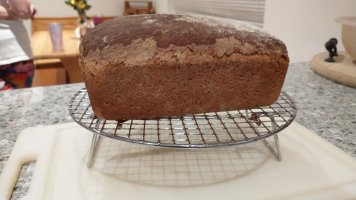 IMG_20211109_192718890.jpg2.7 MB · Views: 0
IMG_20211109_192718890.jpg2.7 MB · Views: 0 -
 IMG_20211114_145641569.jpg4.3 MB · Views: 0
IMG_20211114_145641569.jpg4.3 MB · Views: 0 -
 IMG_20211118_184048257.jpg3.3 MB · Views: 0
IMG_20211118_184048257.jpg3.3 MB · Views: 0
Last edited:
estricklin
Well-Known Member
I'm baking at 375. The pan of water was gone by the time the bread went in the oven. I should put a fresh pan of hot water in at the same time as the loaves.What temperature are you bake them, and when do you remove the pan of water, or how far into the baking time does it last? Increased humidity during the bake should make for a less thick crust. Also wrapping in a tea towel while it is just a touch warm should soften the crust as well.
I also need to get some bread sacks to store the bread in so it doesn't dry out. (the centers don't dry much out even after it's cut) When I take them out, the top crust is already hard as a rock. The sides and bottom are kinda hard but moist. If I put them in a plastic bag right away they would probably mold overnight.
I think maybe I need to brush the tops with melted butter while the loaves are hot, allow them to cool completely on a rack (out of the pan), then put them in plastic bags.
- Joined
- Feb 19, 2017
- Messages
- 959
- Reaction score
- 1,217
Patrick Ryan has a sourdough brie Christmas bread: . Of course, any kind of loaf works. My Christmas version was a whole wheat no knead that ended up a little on the wet side.
But I digress, the beauty is this bread is basically a fondue but i think much better. Prep your loaf, push in a round of brie (or something else), bake, and voila you have melted brie and start hacking off the surrounding bread to dip. It's magical.

But I digress, the beauty is this bread is basically a fondue but i think much better. Prep your loaf, push in a round of brie (or something else), bake, and voila you have melted brie and start hacking off the surrounding bread to dip. It's magical.

PCABrewing
Recreational Brewer
- Joined
- Oct 28, 2021
- Messages
- 816
- Reaction score
- 897
Flour Question:
I hope this is an appropriate question for this forum, if not, please direct me to correctness.
Does anyone have a source for "Malted Barley Flour? Bob's Redmill used to sell it but no longer.
I have seen "Diastatic Flour" that I know has at least a percentage of malt flour, but I would really prefer to have the straight stuff so I can play around a bit with the blend a bit.
I suppose I could buy a mill and grind my own from some 2 or 6 row, but I really don't need another piece of hobby hardware to store.
Any tips on sources?
Any guidance will be appreciated.
I hope this is an appropriate question for this forum, if not, please direct me to correctness.
Does anyone have a source for "Malted Barley Flour? Bob's Redmill used to sell it but no longer.
I have seen "Diastatic Flour" that I know has at least a percentage of malt flour, but I would really prefer to have the straight stuff so I can play around a bit with the blend a bit.
I suppose I could buy a mill and grind my own from some 2 or 6 row, but I really don't need another piece of hobby hardware to store.
Any tips on sources?
Any guidance will be appreciated.
I had gotten some from Amazon… the link: https://www.amazon.com/Breadtopia-D...=B013ADVPZC&psc=1&ref_=pd_bap_d_grid_rp_0_6_iFlour Question:
I hope this is an appropriate question for this forum, if not, please direct me to correctness.
Does anyone have a source for "Malted Barley Flour? Bob's Redmill used to sell it but no longer.
I have seen "Diastatic Flour" that I know has at least a percentage of malt flour, but I would really prefer to have the straight stuff so I can play around a bit with the blend a bit.
I suppose I could buy a mill and grind my own from some 2 or 6 row, but I really don't need another piece of hobby hardware to store.
Any tips on sources?
Any guidance will be appreciated.
Yes, so long as you’ve been milling base grains there will also likely be bits of hull and whatever in there too, but the gov’t allows small amounts of whatever is our food anyway.I was wondering if the powder on my grain mill from crushing grains from brewing isn't the same as diastatic malted barley flour. Does anybody know, thanks?
Do you have an electric coffee grinder? (the kind with a little high-speed blade like a blender) It will grind a couple of tablespoons of malt at a time into flour. You don't need much diastatic malt to make a difference.Flour Question:
I hope this is an appropriate question for this forum, if not, please direct me to correctness.
Does anyone have a source for "Malted Barley Flour? Bob's Redmill used to sell it but no longer.
I have seen "Diastatic Flour" that I know has at least a percentage of malt flour, but I would really prefer to have the straight stuff so I can play around a bit with the blend a bit.
I suppose I could buy a mill and grind my own from some 2 or 6 row, but I really don't need another piece of hobby hardware to store.
Any tips on sources?
Any guidance will be appreciated.
PCABrewing
Recreational Brewer
- Joined
- Oct 28, 2021
- Messages
- 816
- Reaction score
- 897
Thanks, that looks like a good match.I had gotten some from Amazon… the link: https://www.amazon.com/Breadtopia-D...=B013ADVPZC&psc=1&ref_=pd_bap_d_grid_rp_0_6_i
I also stumbled on this, from Walmart no less: https://www.walmart.com/ip/Larissa-Veronica-Malted-Barley-Flour-16-oz-1-Pack-Zin-526343/866777917
Not sure why it didn't hit the last time I searched.
PCABrewing
Recreational Brewer
- Joined
- Oct 28, 2021
- Messages
- 816
- Reaction score
- 897
I considered that, I was hoping to be able to skip the de-hulling step.Do you have an electric coffee grinder? (the kind with a little high-speed blade like a blender) It will grind a couple of tablespoons of malt at a time into flour. You don't need much diastatic malt to make a difference.
Thanks for the idea. I suppose I could crush some first with the grain mill and try to screen out most of the hulls.
But if I can buy some pre-milled as flour I'll take the path of least resistance
Do you have any wheat malt? It has very high diastatic power, and no hulls. If not, just grind the barley malt hulls and all, then sift it. (at least that's what I would do) Good luck! (I see you may have found some for sale at Walmart)I considered that, I was hoping to be able to skip the de-hulling step.
Thanks for the idea. I suppose I could crush some first with the grain mill and try to screen out most of the hulls.
But if I can buy some pre-milled as flour I'll take the path of least resistance
DuncB
Well-Known Member
A little wholemeal malted barley flour will aid a rustic loaf.
Fresh out of the oven
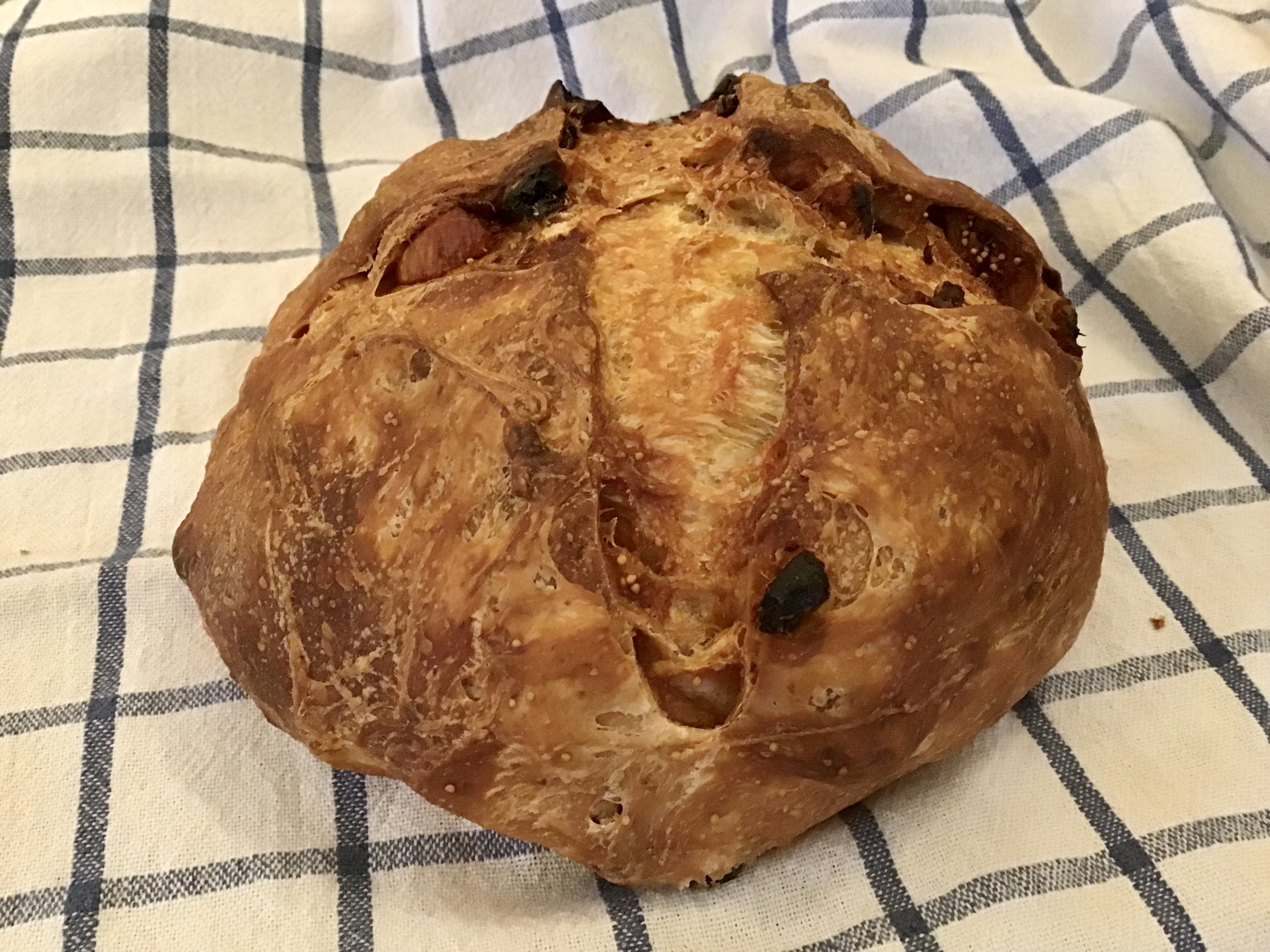 , the first bake of 2023 for me. An enriched sourdough with fig and sultanas.
, the first bake of 2023 for me. An enriched sourdough with fig and sultanas.

Sourdough spelt and milk sandwich loaf.
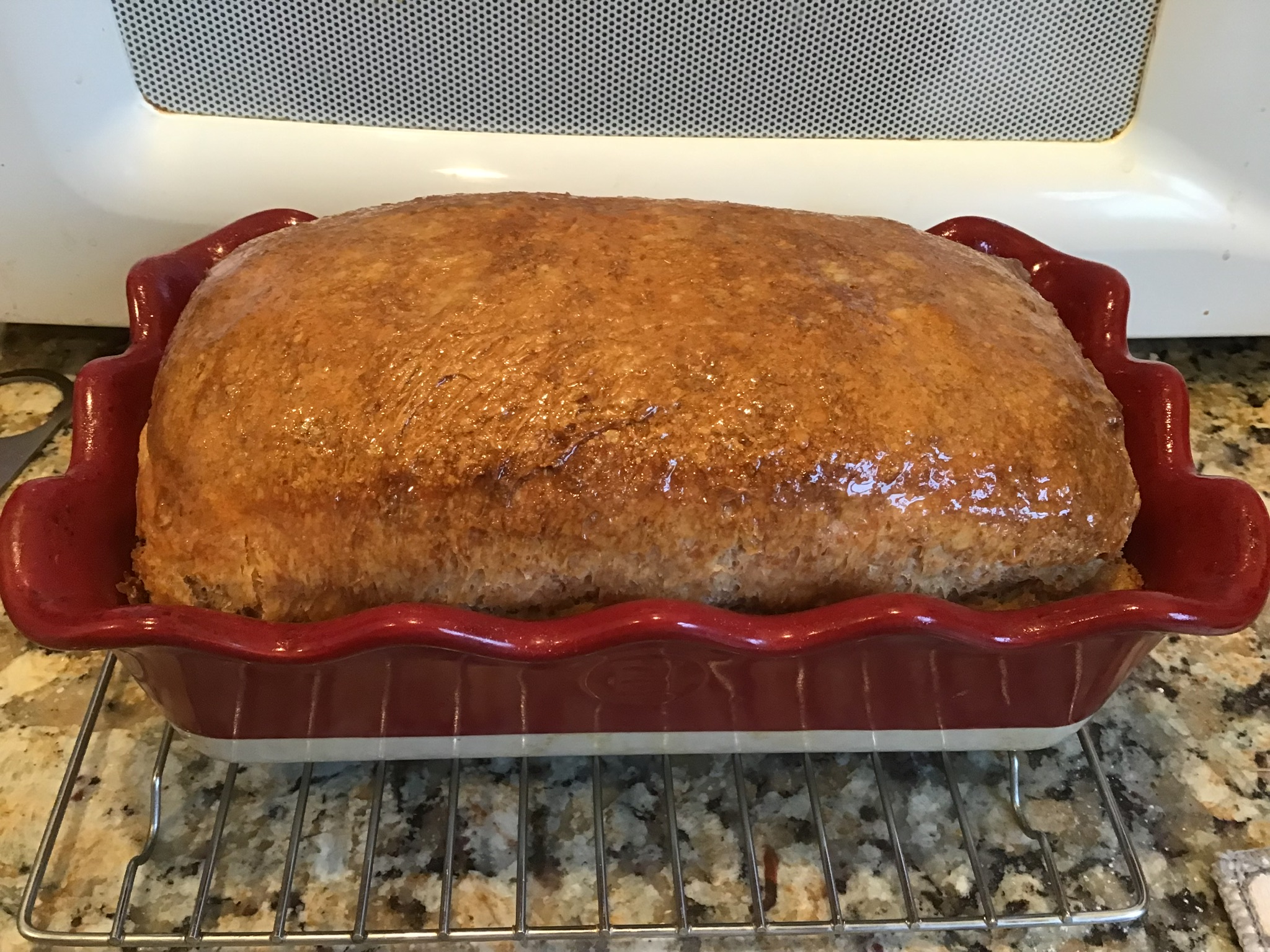



Just getting into baking over the last few months. It's about as much fun as brewing (and faster results).
Made my first loaf of Anadama bread. Still working on getting my loaves to rise evenly from one end to the other, but it still tastes good.

Made my first loaf of Anadama bread. Still working on getting my loaves to rise evenly from one end to the other, but it still tastes good.

estricklin
Well-Known Member
Tried my hand at Tartine, this loaf tastes amazing! My first 2 attempts were failures. I've made sourdough before but not quite in this way, so I didn't do a good job of ensuring my dough was nice and active. I look forward to many more loaves of this quality. I believe it is underbaked every so slightly, I'll adjust baking times next, or just use a thermometer.




I'm attempting a no-knead bread this evening using leftover kefir whey in place of water. Any pointers from people who have used whey like this before?
I've done regular no-knead many times, so I have that process downpat. What I don't know is how the kefir whey affects the no-knead process (if at all). It seems reasonable to assume that yeast may not be needed, but I plan to include a 1/2 tsp of dried yeast anyway just to make sure.
Thanks in advance!
I've done regular no-knead many times, so I have that process downpat. What I don't know is how the kefir whey affects the no-knead process (if at all). It seems reasonable to assume that yeast may not be needed, but I plan to include a 1/2 tsp of dried yeast anyway just to make sure.
Thanks in advance!
Are you using conventional yeast or sourdough? Either way the bulk fermentation might take just a little longer, you can work around that by finding a warm spot to let it rise.I'm attempting a no-knead bread this evening using leftover kefir whey in place of water. Any pointers from people who have used whey like this before?
I've done regular no-knead many times, so I have that process downpat. What I don't know is how the kefir whey affects the no-knead process (if at all). It seems reasonable to assume that yeast may not be needed, but I plan to include a 1/2 tsp of dried yeast anyway just to make sure.
Thanks in advance!
I'm using conventional dry yeast, but I understand that the kefir whey will result in a sourdough-like bread anyway due to its low pH. I'm planning to let it rest overnight and for at least 12 hours.Are you using conventional yeast or sourdough? Either way the bulk fermentation might take just a little longer, you can work around that by finding a warm spot to let it rise.
Yes, the sour flavor should be apparent, it’s still “enriching” the dough, you may use a heavier amount of yeast to keep the timeline the same. I hope that helps. Eager to see how it turns out.I'm using conventional dry yeast, but I understand that the kefir whey will result in a sourdough-like bread anyway due to its low pH. I'm planning to let it rest overnight and for at least 12 hours.
Yes, the sour flavor should be apparent, it’s still “enriching” the dough, you may use a heavier amount of yeast to keep the timeline the same. I hope that helps. Eager to see how it turns out.
Thanks. I did as you suggest and doubled my usual amount of yeast. It's been a while and I went by feel on moisture content, so fingers crossed. I'll share results tomorrow.

Rise from the fridge.
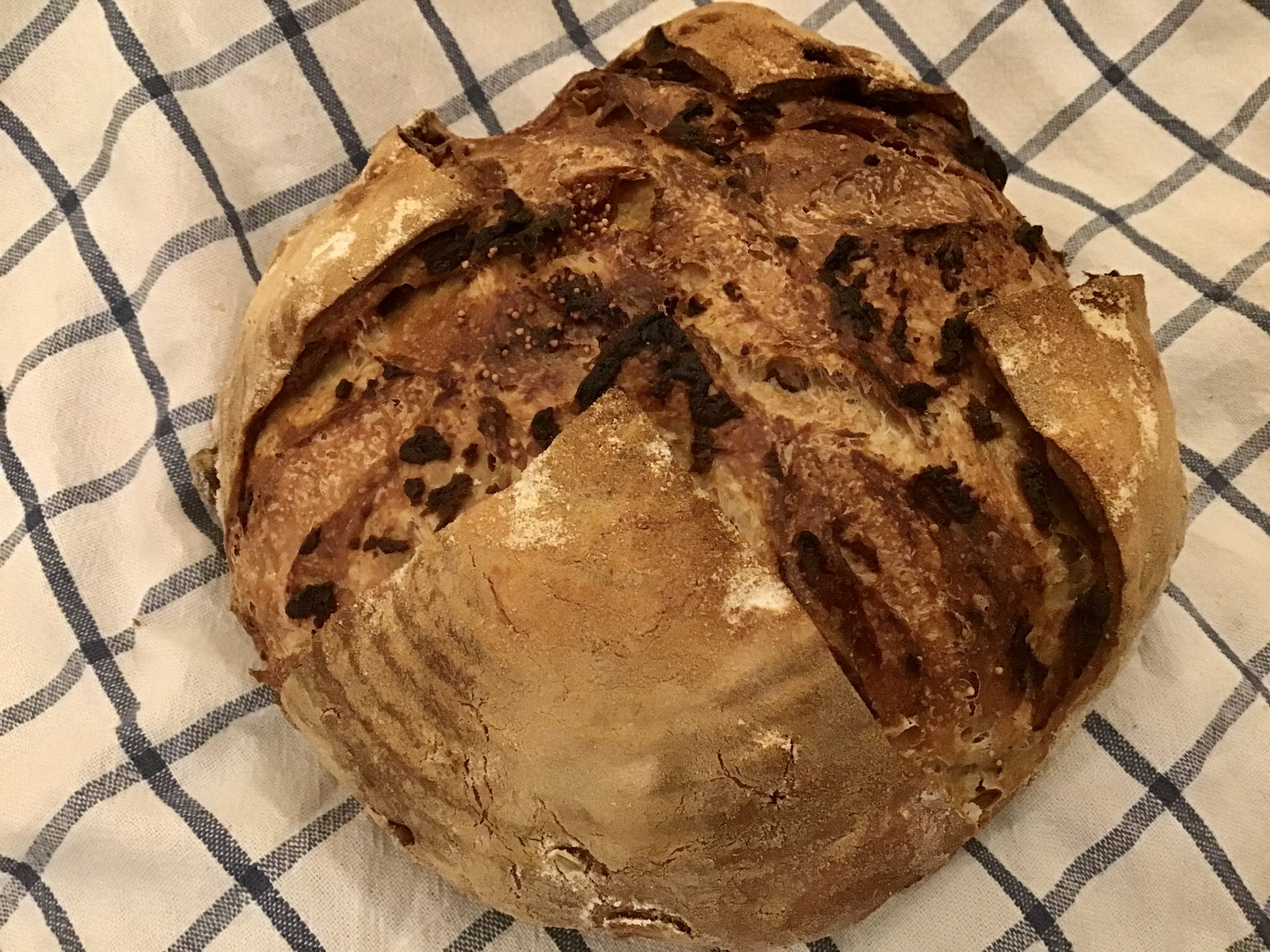
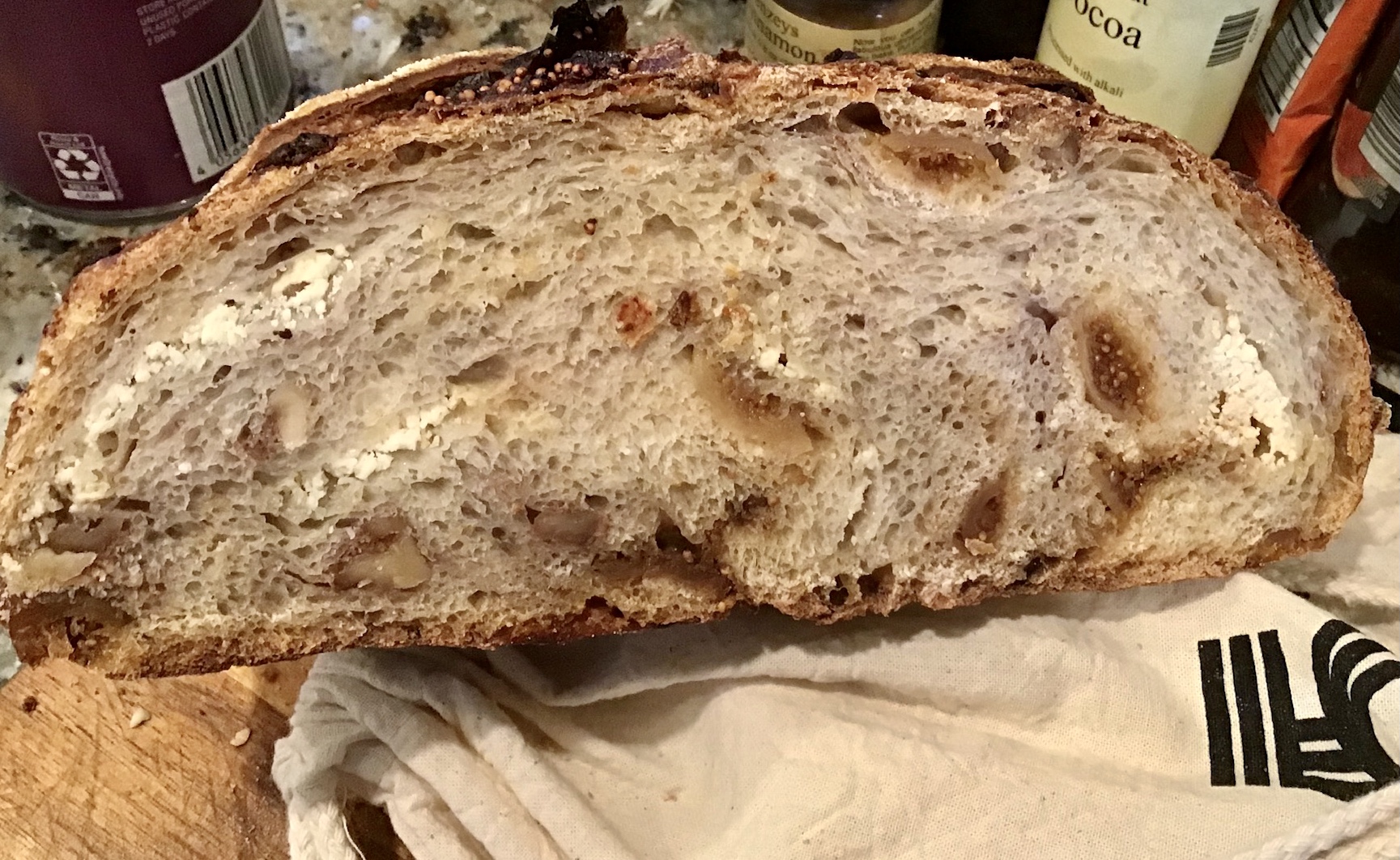
Similar threads
- Replies
- 4
- Views
- 161
- Replies
- 1
- Views
- 136

